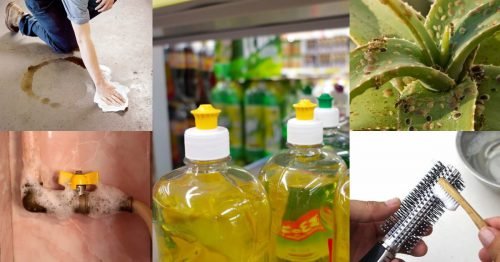Did you know that the dishwashing liquid is one of the most adaptable staples in your household stash? Because the dishwashing liquid is generally mild, it is frequently a better choice as a household cleaner than other harsh chemicals. That is why it can be a great alternative to other harsh cleaners and can be used for many purposes that doesn’t involve any dishes.
Discover the multiple uses of the dishwashing liquid, which can lend so much more help around the house than you think.
A dishwashing liquid functions well on countertops, window sills and other types of surfaces like glass and plastic. Add a small bit of the liquid to a spray bottle filled with warm water, to cleanse away the dirt and grime. Next, wipe over the soapy surface with a well-wrung cloth and allow the surface to dry naturally.
This concoction works very well on outdoor furniture or patio furniture that has been exposed to outdoor dirt and dust. The dishwashing liquid will effectively de-grime any built-in dirt or sticky buildup.
Appliances in the kitchen require regular cleaning, as they are subject to the build-up of sticky grease and stains from cooking. Appliances such as ovens, toasters, blenders, refrigerators and griddles will benefit from the mild and friendly cleansing power of the dishwashing liquid.
Stainless steel cleaners can be very expensive (and harsh if it comes into contact with skin) so using a gentle dishwashing liquid mixed with warm water will polish off stains, fingerprints, and marks leaving your stainless steel appliances sparkling.
Dishwashing liquid is used primarily for removing food from used dishes and tableware. Heavy soil (large food particles) is generally scraped from the dishes before using. Detergent formula can vary based on use (hand or automatic).

Cleaning hairbrushes and combs
Combat residue from hair grooming products like hair wax and mousse with a light solution of a few drops of dishwashing liquid combined with warm water. You can also use dishwashing liquid as a shampoo. For those dealing with greasy tresses, simply apply a coin-sized amount of dishwashing liquid to your hair, lather, then finish by washing with your regular shampoo.
Polishing jewellery back to its original shine
Our jewellery collects dirt with frequent wearing, resulting in dull or cloudy looking accessories. For an easy at-home way to polish jewellery and get it back to its original shine, mix a tiny portion of dishwashing liquid with water and soak the jewellery for 5-10 minutes. If necessary, use a toothbrush to scrub out any stubborn stains.
How To Add Liquid Dishwasher Detergent
FAQ
Do we really need to use dish soap?
What is the science behind dishwashing liquid?
Why is dish soap used for cleaning?
How does dishwashing liquid work?
Dishwashing liquid is specifically formulated for efficient cleaning, making it an excellent choice for tackling tough stains and greasy dishes. Its powerful ingredients work effectively to break down grime and leave dishes sparkling clean. Using dishwashing liquid saves time and effort compared to using regular soap or other cleaning agents.
What is dishwashing liquid?
Dishwashing liquid, also known as dish soap or dish detergent, is a cleaning product specifically formulated for washing dishes. Unlike regular soap, dishwashing liquid is designed to cut through grease and remove stubborn stains, making it more effective for cleaning dishes.
Why is dishwashing liquid important?
Another crucial purpose of dishwashing liquid is to eliminate bacteria and germs that may be present on dishes. Washing dishes solely with water is not adequate for killing harmful microorganisms. Dishwashing liquid, on the other hand, contains antibacterial agents that help to kill germs and prevent the spread of diseases.
Should you use dishwashing liquid?
While dishwashing liquid is excellent for cleaning your dishes, it’s essential to remember that like any product it must be used responsibly. In this article, we’d like to offer some helpful tips on using dishwashing liquid, their do’s and don’ts, and how to maximise sustainability and safety in your everyday dishwashing practice. 1.
